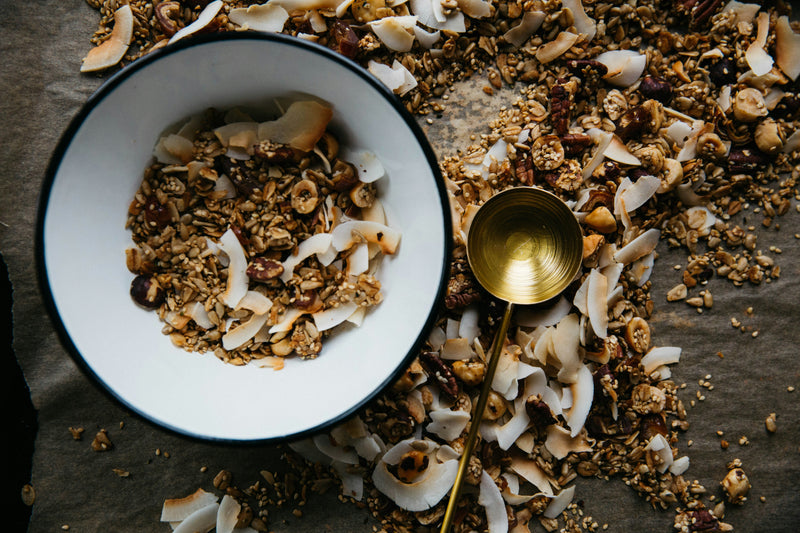91% of Adults Aren’t Eating Enough Fibre—Are You One of Them?
This month we’re looking at how you can add more fibre to your diet, because 91% of UK adults aren’t eating enough of it. We asked our Dietitian Laura to start by explaining why fibre matters, and what you can gain from eating more.


What is fibre?
Fibre is an umbrella term for a group of carbohydrates that we don't digest or absorb. Unlike other carbohydrates in food (which are broken down and used for energy), fibre travels through the gut and lands in the large intestine (colon) where it’s broken down by the bacteria that live there.
Your gut bacteria use fibre for energy, and when they break it down, they produce compounds known as short chain fatty acids (SCFA). SCFA help to keep the lining of your gut healthy. They also help to keep the pH of your gut relatively acidic, which helps prevent pathogenic microbes from taking hold.
What foods contain fibre?
Fibre is found in plant foods, so that means:
- Fruits – fresh, frozen, cooked and dried
- Vegetables – raw and cooked
- Nuts – all types
- Seeds like chia, flax and sunflower
- Beans peas and lentils (aka pulses)
- Wholegrains like oats, wholemeal bread, wholewheat pasta and buckwheat
Why is fibre so important?
The health benefits of a high fibre diet are pretty amazing. Research shows a high fibre diet can:
- Help prevent constipation by bulking out your poo and making it softer and easier to pass
- Maintain a healthy gut environment by helping beneficial microbes thrive and reducing the acidity of the gut
- Help you feel full and satisfied after eating, which can help with reaching and maintaining a healthy bodyweight
- Reduce the risk of long-term conditions like heart disease, stroke and type 2 diabetes
- Protect against bowel cancer
Despite these positives, most of us aren’t eating nearly enough fibre.
How much fibre should I be eating?
The recommended intake is 30 grams a day, but data shows average intakes in the UK are around 19 grams, so we’re a long way off where we need to be. In fact, it’s estimated that only 9% of adults are meeting the 30-gram target.
Where does the 30 gram target come from?
It was published in 2016 after a team of experts carried out a review of the latest evidence looking at fibre intake and health. They found strong evidence that a high fibre diet can protect against heart disease, stroke, type 2 diabetes and bowel cancer.
What does 30 grams look like?
Good question, it’s not easy to know how much fibre is in food, because beyond knowing the types of foods it’s found in (so fruits, vegetables, wholegrains) the fibre content of plant foods can vary a lot.
So, for example, a bowl of spinach only contains about 1.5 grams of fibre where as 3 tablespoons of peas contain 4.5 grams. This is why it’s helpful to know a few of the highest fibre foods so you can include these regularly.
I'll be sharing more on how much fibre is contained in a range of foods over the next few weeks. But to get started, here's a few simple strategies you can use to increase your intake.
- Have a piece of fruit with your breakfast daily - kiwis and raspberries are super fruits for fibre
- Choose oats for breakfast - half a cup of rolled oats = 5g fibre
- Eat vegetables and potatoes with their skins on
- Stir a tablespoon of mixed seeds into yoghurt or overnight oats
- Choose wholemeal, seeded or rye bread over white bread
- Swap to wholemeal or lentil pasta over white pasta
- Add peas to salads, pasta and risotto
- Add lentils or soups and curries
- Snack on dried fruit and nuts
One thing to remember - when increasing your fibre intake, do so slowly to give your gut and microbes time to adjust. I usually suggest one change at a time, and then another a few days later. And drink plenty of water too, as some types of fibre absorb water as they move through the gut.
What if I have a gut condition like IBS?
The 30 gram target is for healthy adults, and we don’t have any different guidelines for people with gut conditions. It's true that some types of fibre – especially fermentable FODMAPs – can aggravate IBS symptoms like gas, bloating and pain, so these are best swapped for less fermentable options.
However, due to the benefits of fibre in terms of microbiome health and health in general, it's a good idea to work towards slowly increasing your fibre intake as far as you can within the limits of your condition. If you have IBS or another gut condition like Crohn's, a dietitian specialising in your condition will be able to help you personalise your approach to adjusting and maximising your fibre intake.
I'll also be sharing ideas on how to maximise your fibre intake when following a low FODMAP diet in the coming weeks.
Our highest fibre meals
All Field Doctor meals are at least a source of fibre because we use lots of vegetables, pulses and wholegrains. But, if you want to order meals to help increase your fibre content, you can choose ‘eat more fibre’ as a goal within our meal personalisation quiz. Or check the list below for some of our highest fibre meals.
- Mediterranean Chickpea Masala Curry – 14 grams of fibre
- Mediterranean Red Pesto and Roasted vegetable penne – 14 grams
- Mediterranean 3 Bean + Smoked Tofu Chilli – 13 grams
- Mediterranean Sweet Potato + Spinach Korma – 13 grams
- Mediterranean Italian Meatballs - 10 grams
- Lean and Lighter Thai Green Chicken Curry -11 grams
- Lean and Lighter 3 Bean + Smoked Tofu Chilli – 11 grams
- Low FODMAP 3 Bean + Smoked Tofu Chilli - 10 grams
- Low FODMAP Moroccan Chickpea Tagine - 10 grams





